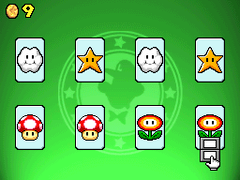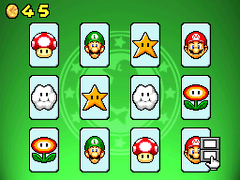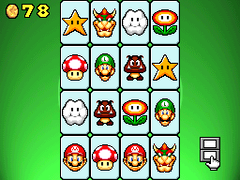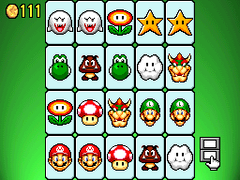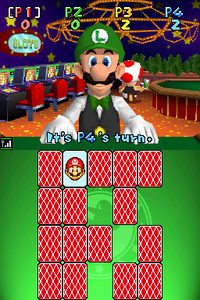Memory Match (Super Mario series)
| Memory Match | |||
|---|---|---|---|
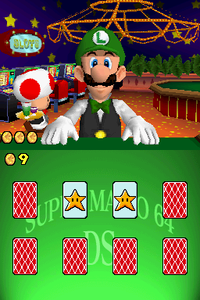 The minigame in Super Mario 64 DS | |||
| Appears in | Super Mario 64 DS New Super Mario Bros. | ||
| Type | Luigi's minigame (Super Mario 64 DS) Table minigame (New Super Mario Bros.) | ||
| |||
Memory Match is one of Luigi's minigames in Super Mario 64 DS and a Table minigame in New Super Mario Bros. This minigame plays identically to the real-world card game Concentration.
A harder version of this minigame called Memory Master is exclusive to Super Mario 64 DS.
Gameplay
Single player
After the player bets three coins, Luigi serves a group of eight cards upside down, and the player must match them up with their twins. At the start, Luigi's cards feature symbols such as a Cloud, a Mushroom, a Fire Flower, and a Super Star. By completing a challenge successfully, the player gains six times the remaining bet coins in Super Mario 64 DS or nine coins in New Super Mario Bros. and receives a Star as a point. As the player earns Stars, the minigame gradually increases in difficulty by adding more cards and symbols, including Mario and Luigi, but also a Goomba, Bowser, a Boo, and Yoshi in the New Super Mario Bros. version of the minigame. For every five Stars earned, additional cards are introduced, and in New Super Mario Bros., hints are provided at the start of each challenge. If the player taps two different cards, a coin is given to Luigi from the bet number, causing the likely loss of a Star if Luigi takes all these coins. If the player loses all of the money to bet, the minigame ends.
The progression for both minigames is detailed in the tables below.
Super Mario 64 DS
| Stars | Image | Symbols | Cards served |
|---|---|---|---|
| 0–4 | 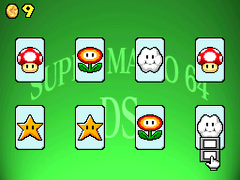 |
|
8 |
| 5–9 | 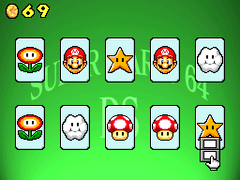 |
|
10 |
| 10 and above | 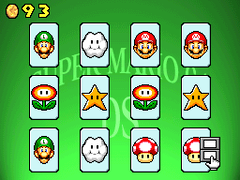 |
|
12 |
New Super Mario Bros.
Multiplayer
In multiplayer mode, which is exclusive to New Super Mario Bros., the minigame features 20 cards arranged in a 5×4 grid similarly to its single-player version after the player reaches 15 Stars. The first player is chosen randomly, and subsequent turns follow this established order. If the cards a player taps match, the player earns two points and gets to go again until they are wrong. Once all the cards are gone, the player with the most points wins. Unlike its single-player counterpart, this version of the minigame does not offer hints at the start of each game.
In-game instructions
- Super Mario 64 DS: "Pick two matching cards to make them disappear. Clear all the cards to win."
- New Super Mario Bros.
- Single player: "Pick two matching cards to make them disappear. Clear all the cards to win. If you make three mistakes, Luigi wins."
- Multiplayer: "Take turns choosing cards. If you find two matching cards, you get to keep them. Which of you has the best memory?"
Names in other languages
| Language | Name | Meaning | Notes |
|---|---|---|---|
| Japanese | ルイージのしんけいすいじゃく[?] Ruīji no Shinkei Suijaku |
Luigi's Concentration Game | |
| Chinese | 记忆测试[1][2] Jìyì Cèshì |
Memory Test | |
| French | Mémorisation[?] | Memorisation | |
| German | Gedächtnistraining[?] | Memory Training | |
| Italian | Accoppiata vincente[?] | Paired winning | |
| Korean | 루이지의 같은 그림 찾기[?] Ruiji ui gateun grim chatgi |
Luigi's Concentration Game | |
| Spanish | Test de Luigi[?] | Luigi's Test |
Trivia
This trivia section is overly long. Please relocate any relevant information into appropriate sections and articles.
- While the gameplay is nearly identical whether the minigame is played in Super Mario 64 DS or New Super Mario Bros., there are still minor differences between those versions:
- The New Super Mario Bros. version of the minigame features additional information in its in-game instructions.
- The number of cards served depending on the Stars earned is different in both games.
- The maximum number of cards served is 20 in New Super Mario Bros., while it is 12 in Super Mario 64 DS.
- The number of coins earned after each challenge is complete depends on the remaining bet coins in Super Mario 64 DS, while it is always nine in New Super Mario Bros.
- In Super Mario 64 DS, the green background behind the cards has "Super Mario 64 DS" written on it, while in New Super Mario Bros., a casino token featuring Luigi's face sideways is drawn.
- After the player earns ten Stars, the New Super Mario Bros. version of the minigame is almost identical to the minigame Memory Master from Super Mario 64 DS, with the only differences being the number of coins bet and the number of hints at the start.
- Since no hints are provided in the Super Mario 64 DS version of the minigame, success largely depends on the random arrangement of the cards after the player earns five Stars or more.
